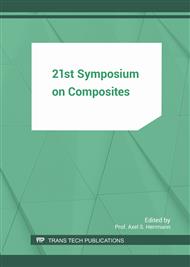[1]
D. Huelsbusch, M. Jamrozy, G. Frieling, Y. Mueller, G.A. Barandun, M. Niedermeier, F. Walther, Comparative characterization of quasi-static and cyclic deformation behavior of glass fiber-reinforced polyurethane (GFR-PU) and epoxy (GFR-EP), Materials Testing 59 (2017).
DOI: 10.3139/120.110972
Google Scholar
[2]
J. Fan, J. Njuguna: An introduction to lightweight composite materials and their use in transport structures, J. Njuguna (Ed. ), Lightweight Composite Structures in Transport, 1st Ed., Woodhead Publishing (2016), p.3 – 34.
DOI: 10.1016/b978-1-78242-325-6.00001-3
Google Scholar
[3]
G. Marsh, Airbus A350 XWB update, Reinf. Plast. 54 (2010), p.20 – 24.
DOI: 10.1016/s0034-3617(10)70212-5
Google Scholar
[4]
R. Renz, R. Szymikowski, Locally resolved hysteresis measurement of advanced glass-mat thermoplastic composites, Int. J. Fatigue 32 (2010), p.174 – 183.
DOI: 10.1016/j.ijfatigue.2009.02.022
Google Scholar
[5]
K.L. Reifsnider (Ed. ), Fatigue of composite materials, Elsevier Science (1991).
Google Scholar
[6]
D. Huelsbusch, F. Walther, Damage detection and fatigue strength estimation of carbon fiber-reinforced polymers (CFRP) using combined electrical resistance and high-frequency impulse measurements, e-journal of Nondestructive Testing 20 (2014).
Google Scholar
[7]
T.P. Philippidis, A.P. Vassilopoulos, Fatigue design allowables for GRP laminates based on stiffness degradation measurements, Compos. Sci. Technol. 60 (2000), p.2819 – 2828.
DOI: 10.1016/s0266-3538(00)00150-0
Google Scholar
[8]
B. von Bernstorff, G.W. Ehrenstein, Failure mechanism in SMC subjected to alternating stresses, J. Mater. Sci. 25 (1990), p.4087 – 4097.
DOI: 10.1007/bf00582486
Google Scholar
[9]
S.C. Garcea, M.N. Mavrogordato, A.E. Scott, I. Sinclair, S.M. Spearing, Fatigue micromechanism characterization in carbon fibre reinforced polymers using synchrotron radiation computed tomography, Compos. Sci. Technol. 99 (2014), p.23 – 30.
DOI: 10.1016/j.compscitech.2014.05.006
Google Scholar
[10]
R. Chaudhari, P. Rosenberg, M. Karcher, S. Schmidhuber, P. Elsner, F. Henning, High-pressure RTM process variants for manufacturing of carbon fiber-reinforced composites, Proc. 19th Int. Conference on Composite Materials, Montreal (2013).
DOI: 10.1063/1.4873822
Google Scholar
[11]
F. Walther, Microstructure-oriented fatigue assessment of construction materials and joints using short-time load increase procedure, Materials Testing 56 (2014), p.519 – 527.
DOI: 10.3139/120.110592
Google Scholar
[12]
J. Brunbauer, F. Arbeiter, S. Stelzer, G. Pinter, Stiffness based fatigue characterization of CFRP, Advanced Materials Research 891-892 (2015), p.166 – 171.
DOI: 10.4028/www.scientific.net/amr.891-892.166
Google Scholar
[13]
F. Orth, G.W. Ehrenstein, Werkstoffauswahl bei dynamischer Belastung, Kunststoffe 79 (1989), p.727 – 731.
Google Scholar
[14]
M. Kempf, O. Skrabala, V. Altstaedt, Acoustic emission analysis for characterisation of damage mechanisms in fibre-reinforced thermosetting polyurethane and epoxy, Composites Part B 56 (2014), p.477 – 483.
DOI: 10.1016/j.compositesb.2013.08.080
Google Scholar


